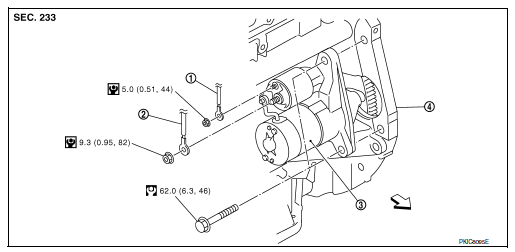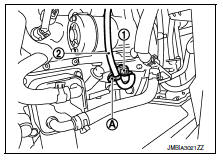Nissan Sentra Service Manual: Removal and installation
Starter motor
Exploded View

- “S” terminal harness
- “B” terminal harness
- Starter motor
- Cylinder block
Removal and Installation
NOTE:
When removing components such as hoses, tubes/lines, etc., cap or plug openings to prevent fluid from spilling.
REMOVAL
- Disconnect the battery negative terminal. Refer to PG-50, "Removal and Installation (Battery)".
- Remove fan shroud and motor assembly. Refer to CO-17, "Component".
- Remove reservoir hose upper from radiator to water outlet. Refer to CO-15, "Exploded View".
- Remove “B” terminal nut and “B” terminal harness.
- Remove “S” terminal nut and “S” terminal harness.
- Disconnect harness connector from oil temperature sensor. Refer to EM-94, "Exploded View".
- Disconnect harness connector (1) from crankshaft position sensor.
- Remove harness clip (A) from oil pan (upper), and then remove harness (2) and set aside.

- Remove upper starter motor bolt.
- Remove lower starter motor bolt and remove starter motor.
- Installation is in the reverse order of removal.
- Refill engine coolant. Refer to CO-12, "Changing Engine Coolant".
CAUTION:
- Be careful to tighten "B" terminal nut to the specified torque.
 Symptom diagnosis
Symptom diagnosis
Starting system
Symptom table
Symptom
Reference
No normal cranking
Refer to STR-20, "Work Flow (With GR8-1200 NI)" or
STR-24, "Work Flow (Without GR8-1200 NI ...
 Service data and specifications (SDS)
Service data and specifications (SDS)
Starter Motor
*: Always check with the Parts Department for the latest parts information. ...
Other materials:
P2014, P2016, P2017, P2018 Intake manifold runner control valve position
sensor
DTC Logic
DTC DETECTION LOGIC
NOTE:
If DTC P2014, P2016, P2017 or P2018 is displayed with DTC P0643, first
perform the trouble diagnosis
for DTC P0643. Refer to EC-353, "DTC Logic".
DTC No.
CONSULT screen terms
(Trouble diagnosis content)
DTC detecting condition
P ...
Seats
WARNING
Do not ride in a moving vehicle when
the seatback is reclined. This can be
dangerous. The shoulder belt will not
be against your body. In an accident,
you could be thrown into it and receive
neck or other serious injuries. You
could also slide under the ...
P2138 APP Sensor
DTC Logic
DTC DETECTION LOGIC
NOTE:
If DTC P2138 is displayed with DTC P0643, first perform the trouble
diagnosis for DTC P0643. Refer to
EC-353, "DTC Logic".
DTC No.
CONSULT screen terms
(Trouble diagnosis content)
DTC detecting condition
Possible cause
...
